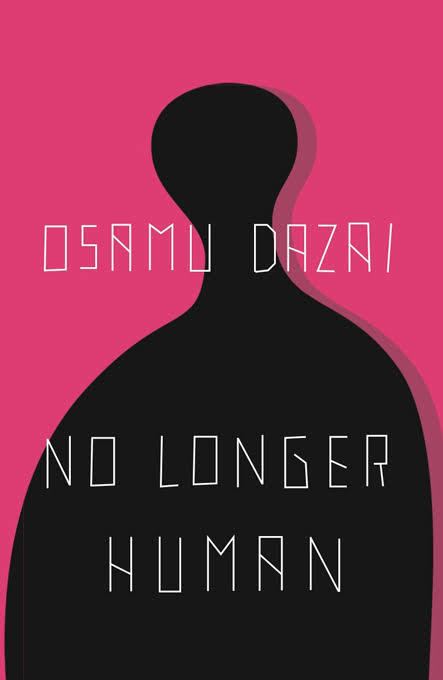7.8 /10 1 Votes
3.6/5 Barnes & Noble Original title 人間失格 Country Japan Page count 177 | 4/5 Goodreads 8.3/10 MyAnimeList Cover artist Rodrigo Corral Originally published 1948 | |||||||||||||||||||||||||||||||||
 | ||||||||||||||||||||||||||||||||||
Publication date 1948 (English translation 1958) Similar Osamu Dazai books, Japan books, Novels | ||||||||||||||||||||||||||||||||||
No Longer Human (人間失格, Ningen Shikkaku) is a Japanese novel by Osamu Dazai. Published after Run Melos and The Setting Sun, No Longer Human is considered Dazai's masterpiece and ranks as the second-best selling novel in Japan, behind Natsume Sōseki's Kokoro.
Contents
The literal translation of the title, discussed by Donald Keene in his preface to the English translation, is "Disqualified from Being Human". (The Italian translation was titled Lo squalificato, The Disqualified.)
This novel, despite being serialized as a work of fiction in 1948, is narrated in the first person and contains several elements which betray an autobiographical basis, such as suicide—a recurring theme in the author's life. Many also believe the book to have been his will, as he took his own life shortly after the last part of the book was published, on June 13, 1948.
One modern analyst has proposed Dazai was suffering from complex post-traumatic stress disorder when he wrote the book.
Manga probe series discussion no longer human
Plot outline
No Longer Human is told in the form of notebooks left by one Ōba Yōzō (大庭葉蔵), a troubled man incapable of revealing his true self to others, and who is instead forced to uphold a facade of hollow jocularity.
The novel is composed of three chapters, or "memoranda", which chronicle the life of Ōba from early childhood to late twenties.
The story is bookended with two other, shorter chapters from the point of view of a neutral observer, who sees three photos of Ōba and eventually tracks down one of the characters mentioned in the notebooks who knew him personally.
Ōba refers to himself throughout the book using the reflexive pronoun "Jibun" (自分), whereas the personal pronoun "Watashi" (私) is used both in the foreword and afterword to the book by the writer, whose name is unclear. The name "Ōba" is actually taken from one of Dazai's early works, "Petals of Buffoonery" (道化の華).
Movie
Ningen Shikkaku was adapted to film in 2009, the 100th anniversary of Dazai's birth. The film was directed by Genjiro Arato, the producer responsible for the award-winning Zigeunerweisen in 1980. Filming started in July, and it was released on February 20, 2010.
The film stars Toma Ikuta (24) as Ōba Yōzō, a young man who finds it hard to relate to the world around him, but masks this sense of alienation with a jovial demeanor. Still, his life spirals toward self-destruction. Actress Satomi Ishihara (22) plays one of the several women in his life, and the only one he marries.
The film was marketed outside Japan under the title Fallen Angel.
Anime
Another adaption of the story was told in the four first episodes of the anime series Aoi Bungaku that was released in 2009. The anime won the Platinum Grand Prize at the Future Film festival in Italy.
An anime titled Bungou Stray Dogs features a character named after Osamu, as well as various influences from No Longer Human.
Manga
Usamaru Furuya created a three-volume manga version of No Longer Human, serialized in Shinchosha's Comic Bunch magazine beginning in number 10, 2009. An English edition was published by Vertical, Inc. in 2011–2012.
Yasunori Ninose created another manga version of No Longer Human, titled Ningen Shikkaku Kai (壊,"kai" = "destruction"), serialized in Champion Red from April to July in 2010. Unlike Furuya's version, this manga depicts human beings' negative emotion and sexual intercourse as tentacles, which have enthralled Ninose since he was five years old.
A third version (ISBN 978-4872578102), a straight retelling of the story in its original pre-WWII setting, was commissioned for the Manga de Dokuha series (comic adaptations of classic literature), published by Gakken. An English edition was published in online format by JManga in 2011.
Reception
William Bradbury of The Japan Times called it a timeless novel, saying that "The struggle of the individual to fit into a normalizing society remains just as relevant today as it was at the time of writing." Serdar Yegulalp of Genji Press noted the strength of Dazai in portraying the situation of the protagonist, describing the novel as "bleak in a way that is both extreme and yet also strangely unforced". Both critics have noted the autobiographical qualities of the novel, but claim that Dazai's style causes readers to connect to Ōba rather than focus on the author.
